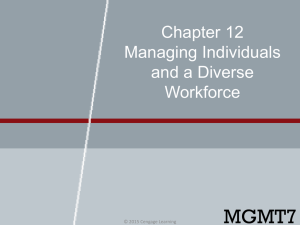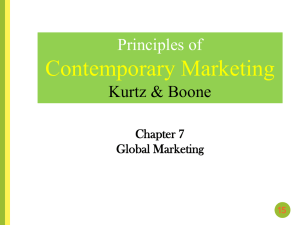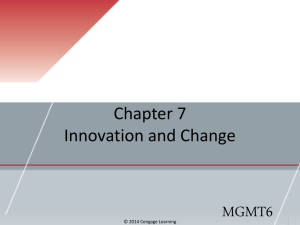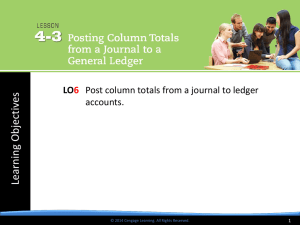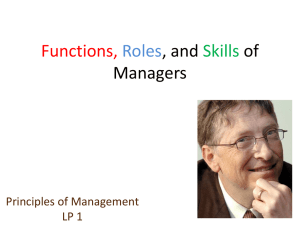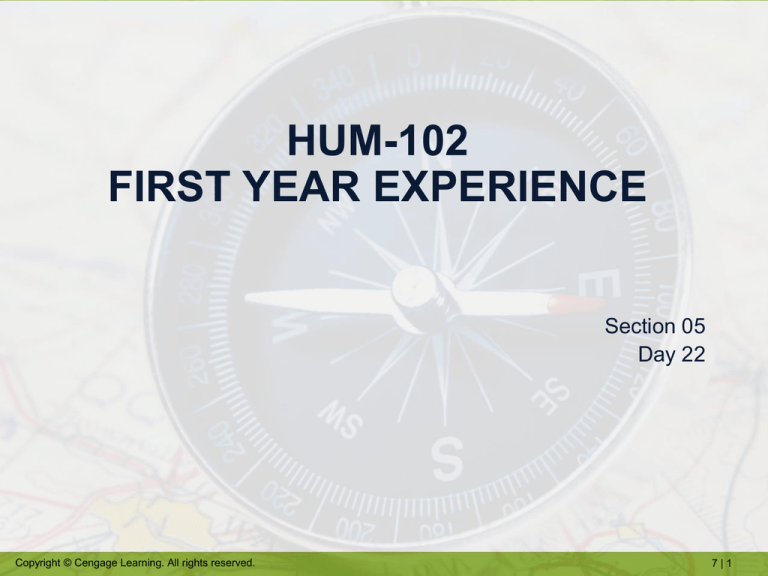
HUM-102
FIRST YEAR EXPERIENCE
Section 05
Day 22
Copyright © Cengage Learning. All rights reserved.
7|1
Agenda
• OD Topic statement due
• OnCourse Journals 8 & 9 posted
– Due Nov 21 and Dec 1
• OnCourse Refection paper posted
– Due Dec 8
• Passport entries
• Exam 2 Discussion
– 10 A’s, 1 B, 1 C and 1 F
• Today we will be discussing Emotional
Intelligence
Copyright © Cengage Learning. All rights reserved.
7|2
New Schedule
•
Nov 17 & 21 Chap 8 Developing Emotional Intelligence
– OD Topic due Today
– Journal 8 due Nov 21…Journal 32 …just describe Mandala, or take a picture of it
•
Nov 28 Chap 9 Staying on Course to Your Success (Journal 9)
– OD Lit. review and outline due
•
Dec 1st OD Chap 3 Review,
– Journal 9 due
•
•
Dec 5 Exam #3 Chap 7-9, OD chap 3 (10%)
Dec 8
– OnCourse Refection paper due (journals & paper, 20%), instructions and upload
in OnCourse Journal Content area.
•
Dec 12 @ 10 AM Paper & Presentations
– OD paper due (15%)
Copyright © Cengage Learning. All rights reserved.
7|3
On Course
Strategies for Creating Success
in College and in Life
Chapter 8
Developing Emotional Intelligence
CHOICES OF SUCCESSFUL STUDENTS
DEVELOPING EMOTIONAL INTELLIGENCE
Copyright © Cengage Learning. All rights reserved.
7|5
REVIEW:
COMPONENTS OF LOGICAL ARGUMENT
Which component
answers the question
“Why?”
Facts, data and
stories are examples
of which component?
Which component
includes opinions,
beliefs or positions?
Copyright © Cengage Learning. All rights reserved.
Reasons
Evidence
Conclusions
7|6
REVIEW: TYPES OF LEARNERS
What are the four learning preferences?
Thinking
Doing
Feeling
Innovating
Copyright © Cengage Learning. All rights reserved.
7|7
REVIEW:
DEVELOPING SELF-RESPECT
What are two crucial choices that build up or
tear down my self-respect?
To live with integrity…or not.
To keep commitments…or not.
Copyright © Cengage Learning. All rights reserved.
7|8
One candy corn now?
Or two in 15 min?
Copyright © Cengage Learning. All rights reserved.
7|9
CASE STUDY IN CRITICAL THINKING
AFTER MATH
Decide which character in the story has the least
emotional intelligence.
Prof. Bishop, Elena, Scott, Michael, Kia
Gather in groups with people who chose the same
character as least emotionally intelligent and
choose a spokesperson.
Each group, provide your spokesperson with
reasons and evidence that support your
conclusion.
Each spokesperson, use your best critical thinking
skills to persuade others to leave their group and
join yours.
Copyright © Cengage Learning. All rights reserved.
7 | 10
CASE STUDY IN CRITICAL THINKING
AFTER MATH
DIVING DEEPER: Imagine that you have
been asked to mentor the person whom you
ranked number 5 (least emotionally
intelligent). Other than recommending a
counselor, how would you suggest that this
person handle his or her upset in a more
emotionally intelligent manner?
Copyright © Cengage Learning. All rights reserved.
7 | 11
DEVELOPING EMOTIONAL INTELLIGENCE
FOCUS QUESTIONS
What is emotional intelligence?
How can you experience the full range of
natural human emotions and still stay on
course to a rich, fulfilling life?
Copyright © Cengage Learning. All rights reserved.
7 | 12
FOUR COMPONENTS
OF EMOTIONAL INTELLIGENCE
EMOTIONAL SELF-AWARENESS
Knowing your feelings in the moment.
EMOTIONAL SELF-MANAGEMENT
Managing strong feelings.
SOCIAL AWARENESS
Empathizing accurately with other people’s emotions.
RELATIONSHIP MANAGEMENT
Handling emotions in relationships with skill and
harmony.
Rate your self.
Which is highest and which is lowest?
Copyright © Cengage Learning. All rights reserved.
7 | 13
APPLYING THE CONCEPT
Read each description; then decide which component of
emotional intelligence is being demonstrated.
EMOTIONAL
Candace notices that her
breathing is accelerated, her
SELFchest feels tight and her jaw
AWARENESS
muscles are clenched and
realizes her anger is escalating.
Alex is furious after discovering
EMOTIONAL
that his roommate has eaten all
of the snacks that Alex bought. SELF-MANAGEMENT
Alex decides to take a long walk
and think before confronting him
about the situation.
Copyright © Cengage Learning. All rights reserved.
7 | 14
APPLYING THE CONCEPT
Halalo’s friends come from very different
backgrounds: one from New York city, two
from St. Louis, one from a family farm in
southern Missouri and one from a small town
in eastern Oregon. Still, he can tell when
each of them is upset about something.
Mikel knows that Annette flunked the same
test on which Kerri scored a “95.” Instead of
telling Annette she should have spent more
time studying, he lets her vent her feelings
about the test and the class. Later, he asks
Annette if she would like to join his study
team.
Copyright © Cengage Learning. All rights reserved.
SOCIAL
AWARENESS
RELATIONSHIP
MANAGEMENT
7 | 15
JOURNAL 28: WARM-UP
Write a list of as many emotions as you can think
of. (4 minutes)
Form groups of four and read your lists to each
other. As you hear emotions that are not on your
list, add them.
One at a time, each person share the emotion that
gives him/her the greatest challenge in managing.
Group members, offer suggestions for how the
person can better manage that emotion. (3
minutes each)
Copyright © Cengage Learning. All rights reserved.
7 | 16
REDUCING STRESS
FOCUS QUESTION
How can you soothe stressful feelings that
make life unpleasant and threaten to get you
off course?
Copyright © Cengage Learning. All rights reserved.
7 | 17
STRESS: SYMPTOMS
As you read the symptoms appearing below, jot down each
one that you are currently experiencing.
high blood pressure
headaches
indigestion
ulcers
chronic constipation or diarrhea
tics
sexual dysfunction
insomnia
muscle tension
backaches
irritability
cold sores
muscle spasms
tremors
fatigue
emotional upsets
Are there other symptoms in your life that may be caused
by stress?
On a scale of 1-10 (10 = high stress), what do you think
is your present level of stress?
Copyright © Cengage Learning. All rights reserved.
7 | 18
SYMPTOMS OF STRESS
From the following list, identify which
emotion is most likely to get you off course:
•
•
•
•
•
OVERWHELM
ANGER AND RESENTMENT
FEAR AND ANXIETY
SADNESS AND DEPRESSION
JOY AND HAPPINESS
Copyright © Cengage Learning. All rights reserved.
7 | 19
TRUTH IN CARTOONS
With a partner, examine “The Far Side” cartoon by
Gary Larson in the section titled “Healthy Stress
Reduction.” (page 322) Discuss:
• What is funny about this cartoon?
• What truth is expressed in this cartoon?
• How could you apply this truth to improve
your own life?
Copyright © Cengage Learning. All rights reserved.
7 | 20
CREATING FLOW
FOCUS QUESTIONS
What are you doing when you feel most
happy to be alive—when you become so
absorbed that time seems to disappear?
How can you create more of these peak
experiences in college and beyond?
Copyright © Cengage Learning. All rights reserved.
7 | 21
QUOTATIONS
Choose your favorite quotation from the
margins of the "Creating Flow" section.
Form groups with other students who chose
a different quotation.
In your group, share the quotation you
selected, what it means to you, and your
reasons for choosing it.
Copyright © Cengage Learning. All rights reserved.
7 | 22
Your work is going to fill a large part of your
life, and the only way to be truly satisfied is
to do what you believe is great work. And
the only way to do great work is to love
what you do. If you haven't found it yet,
keep looking. Don't settle. As with all matters
of the heart, you'll know when you find it.
-Steve Jobs, Former CEO,Apple Computer
Copyright © Cengage Learning. All rights reserved.
7 | 23
BECOMING AN ACTIVE LEARNER
Skill +
= Boredom
+ Challenge = Anxiety
Skill + Challenge = Flow
Challenge
Skill
This is an example of conveying meaning in a visual
way. Translate the meaning into words.
Copyright © Cengage Learning. All rights reserved.
7 | 24
DEVELOPING EMOTIONAL
INTELLIGENCE AT WORK
On Course identifies five indicators for
identifying instructors who create flow in
their classrooms (see "College and Flow,
page 331").
Can you identify professors(s) that create
flow at UMFK?
Will you be a teacher that creates flow?
Copyright © Cengage Learning. All rights reserved.
7 | 25
BELIEVING IN YOURSELF:
DEVELOP SELF-LOVE
FOCUS QUESTIONS
How much do you love yourself?
What can you do to love yourself even
more?
Copyright © Cengage Learning. All rights reserved.
7 | 26
BELIEVING IN YOURSELF:
DEVELOP SELF-LOVE
Self-Care Plan
• Nurture Yourself Physically
• Nurture Yourself Mentally
• Nurture Yourself Emotionally
Which of these is the area in which you
need to work on most ?
Form small groups with others who chose
the same area and discuss the suggestions
from the text.
Copyright © Cengage Learning. All rights reserved.
7 | 27
EMBRACING CHANGE:
DO ONE THING DIFFERENT THIS WEEK
Look at the list of nine beliefs and behaviors.
Which of these choices is most likely to help
you move closer to your desired outcomes
and experiences?
Write about your choice, using one or more
of the 4E’s (examples, experiences,
explanation, evidence).
Copyright © Cengage Learning. All rights reserved.
7 | 28
WISE CHOICES IN COLLEGE:
MANAGING MONEY
Pair up and look at the chart in On Course
showing level of education, median earnings and
unemployment rate.
Discuss:
What educational degree raises your potential
salary the most?
What effect does education have on your
likelihood of being employed?
What other conclusions can you draw from the
chart?
What effect did examining this chart have on your
motivation to continue college?
Copyright © Cengage Learning. All rights reserved.
7 | 29
WISE CHOICES IN COLLEGE:
MANAGING MONEY
Choose the strategy for "Increasing Money
Flowing In“ that has the greatest chance of
increasing your abundance.
Join with one or two other students who
made the same choice.
Together, develop a Next Actions list to put
the strategy into action.
Copyright © Cengage Learning. All rights reserved.
7 | 30
WISE CHOICES IN COLLEGE:
MANAGING MONEY
Choose the strategy for “Decreasing the
Flow of Money Out“ that has the greatest
chance of increasing your abundance.
Join with one or two other students who
made the same choice.
Together, develop a Next Actions list to put
the strategy into action.
Copyright © Cengage Learning. All rights reserved.
7 | 31
REVIEW & SUMMARY
What are the three options or components of
a self-care plan?
Nurture Yourself Physically
Nurture Yourself Mentally
Nurture Yourself Emotionally
Copyright © Cengage Learning. All rights reserved.
7 | 32
REVIEW & SUMMARY
What are some of the physical symptoms of
stress?
high blood pressure
headaches
indigestion
ulcers
chronic constipation/diarrhea
tics
sexual dysfunction
emotional upsets
Copyright © Cengage Learning. All rights reserved.
muscle tension
backaches
irritability
cold sores
muscle spasms
tremors
fatigue
insomnia
7 | 33
REVIEW & SUMMARY
What are the four components of emotional
intelligence?
Emotional Self-Awareness
Emotional Self-Management
Social Awareness
Relationship Management
Copyright © Cengage Learning. All rights reserved.
7 | 34
REVIEW & SUMMARY
What are some of the positive benefits of
developing emotional intelligence in the
college setting?
What are some of the positive benefits of
developing emotional intelligence in the
work setting?
Copyright © Cengage Learning. All rights reserved.
7 | 35
KEY CHOICES TO DEVELOPING
EMOTIONAL INTELLIGENCE
Creating
Flow
Reducing
Stress
Understanding
Emotional
Intelligence
Copyright © Cengage Learning. All rights reserved.
7 | 36
TICKET OUT
What do you think will be the most
rewarding aspect of developing
Emotional Intelligence? Why?
Copyright © Cengage Learning. All rights reserved.
7 | 37
End
Chapter
Eight
Copyright © Cengage Learning. All rights reserved.
7 | 38
To DO list
• Before Next Class
– Do Journal 8
– For Journal 31, part 1, just describe your Mandala
•Finish Passport
Entries!!!!!!!!!!!
Copyright © Cengage Learning. All rights reserved.
7 | 39



